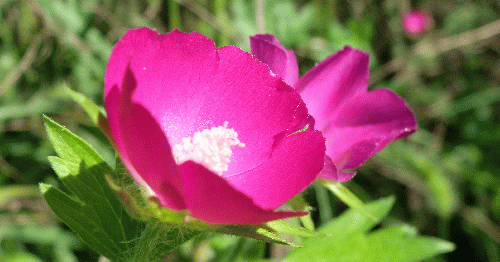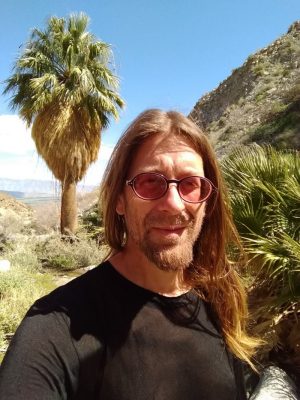
Purple Poppy Mallow (Callirhoe involucrata) — Photo by author
(Image by Kollibri terre Sonnenblume) Details DMCA
The following is an excerpt from my new book, "Roadtripping at the End of the World."
I was born and raised in Nebraska, but my curiosity about the native prairies was not piqued until years later. In September 2018, over twenty-five years since the last time I lived in the state, I finally visited a remnant of original, unplowed prairie, located outside the city of Lincoln and entirely surrounded by the farmland that replaced most of it. I was entranced by what I found.
As an ecosystem type, prairies exist in conditions too moist for desert flora and too dry to support forest. Grasses are the most prevalent family of plants, both in number of species and in sheer mass. Forbswhich are non-grass plants without woody stems (so, not trees or shrubs)are less common but totally essential. Trees are rare except near water.
The prairies of the Great Plains formed two to five thousand years after the last glaciers retreated. Retreating ice left behind mixed sediments that were gradually built into topsoil over many centuries with the addition of wind-borne dust and decayed organic matter.The ecosystem co-evolved with various animals including Buffalo, Elk, Deer, Rabbits, and Prairie Dogs, the last of whom played an important role in aerating the soil and creating channels for water penetration with their extensive tunneling.
At one time, prairies dominated Illinois, southern and western Minnesota, Iowa, northern Missouri, southwestern Manitoba, both Dakotas, Nebraska, Kansas, Oklahoma, central Texas, southern Saskatchewan, southeastern Alberta, Montana, and the eastern parts of Wyoming, Colorado and New Mexico. At their peak, the North American prairies covered 677,394 square miles, an area nearly a quarter (23%) the size of the lower 48 states. Within this vast zone, Tallgrass prairies grew in the east, where it was wetter at a lower elevation, and Shortgrass prairie in the west, where it was drier and higher, with Mixed Grass prairie taking up a wide band in between.
Grasses might strike most people as boring, but the many species found in Tallgrass Prairies are not the stuff of lawns. Growing three to six feet high, they send down roots five to twelve feet. Though their vegetative portion is the most obvious part to usand is indeed tallthe majority of the plant's bulk is underground; in the case of Big Bluestem grass, the volume of the roots is two to four times greater than the foliage. The masses of roots often form thick, perennial rhizomes that both spread horizontally and dig down deeply. How big can they get? According to Paul A. Johnsgard of the School of Biological Science at the University of Nebraska-Lincoln, the famous ecologist John Weaver "once calculated that a square foot of big Bluestem sod might contain about 5 5 linear feet, and an acre about 400 miles of densely matted rhizomes, from the surface to a depth of only a few inches." Johnsgard goes on to say: "The strong roots of big bluestem have individual tensile strengths of 55-64 pounds, making prairie sod one of the strongest of natural organic substances. It is indeed strong enough to construct sod-built houses that have sometimes lasted a century or more in the face of Nebraska's relatively inhospitable climate."[1]
All of this plant material, both above and below ground, ends up producing a lot of decomposed organic matter every season: about 3000 pounds per acre on the surface and 2000 per acre underground. The turnover ratefrom production to decompositionis also fast, taking about 15 months above ground and 3-4 years below. This contrasts greatly with ecosystems that feature more trees and shrubs; with such woody plants, turnover rate can be measured in decades.[2]
Fire played a crucial role in maintaining vegetation on the prairie by suppressing trees, returning nutrients to the soil, and clearing away vegetative detritus. Animals loved the fresh green shoots that popped up afterwards. Herds of Buffalo would travel hundreds of miles to graze such spots.[3]
Native Americans called prairie fires the "Red Buffalo" and they set them intentionally as part of their gathering and hunting activities. Given that the prairies are only five to eight thousand years old, and that humans have been living in the Americas for much longer, the role that the Native Americans played was possibly foundational. Some have described their actions as comprising "land management," but that term is problematic given the contrast between Native American and European relationships to the land, the former being more participatory and the latter more dominating, if not malicious. "Wildtending" is a better word.
The "opening of the West" to colonial settlement had a devastating effect on the prairie ecosystems and their denizens. The invaders who rushed into these lands in the 1800s, especially after the building of the cross-country railroad, plowed under the grasslands and hunted the Buffalo nearly to extinction.
The slaughter of the Buffalo herds by Europeans is an event of such enormous scale that I would characterize it as unimaginable. In 1800, these animals numbered in the range of 30-60 million. Accounts from that time describe herds of animals stretching to the horizon. Try to picture that. I can't. My eye knows only the colonized landscape: tilled under, chopped down, or raked over.
The commercial hide industry is what lead to the Buffalo's near extinction. Highly organized hunting parties killed hundreds, if not thousands, of animals every day. Hides were pulled off the carcasses by pounding a spike through the dead animal's nose and hooking it up to a team of horses. The remainder of the animal was left to rot. Later, impoverished settlers collected the bones which were shipped to factories for making fertilizer.
Profit was not the only motive. It was well known that the Native American tribes of the Great Plains depended on the Buffalo for food and that by wiping out the animals, you would be threatening the humans. Decisions at the federal level in Washington, D.C., supported this policy. When a government intentionally sets out to destroy a group of people based on ethnicity, that's the definition of "genocide."
By the 1880's the Buffalo had been reduced to a few hundred. Some were protected on private ranches by individuals wishing to save them. The last remnant of truly wild Buffalo hid out in a valley in Yellowstone National Park and numbered just 23 at its lowest point.[4]
(Note: You can view every article as one long page if you sign up as an Advocate Member, or higher).





